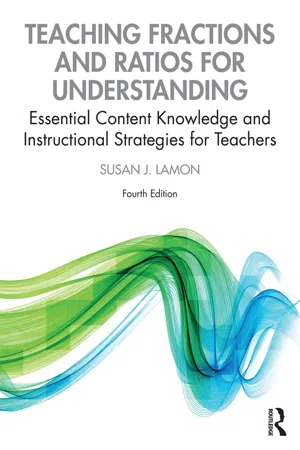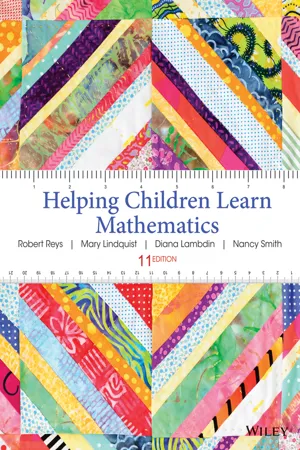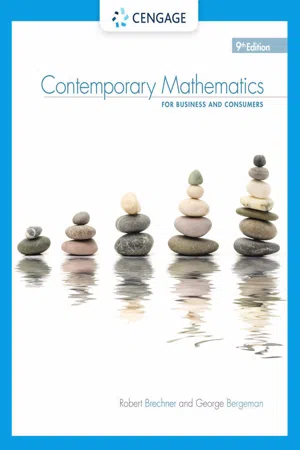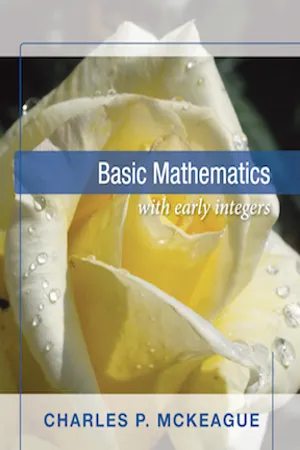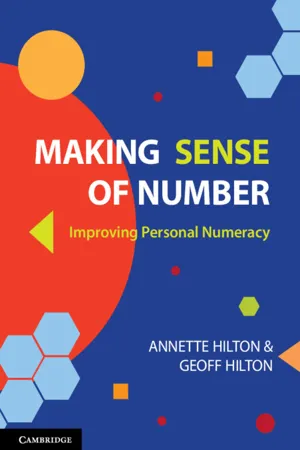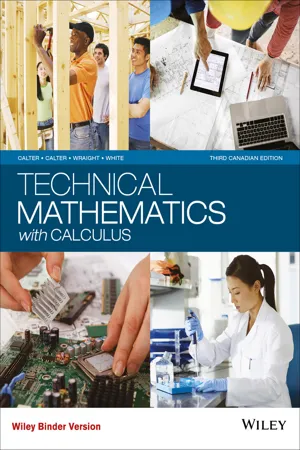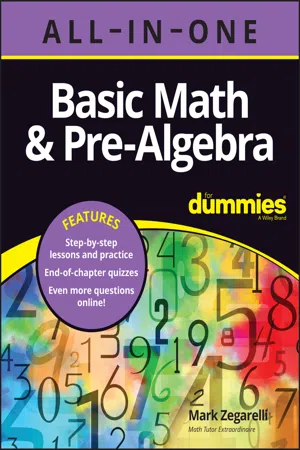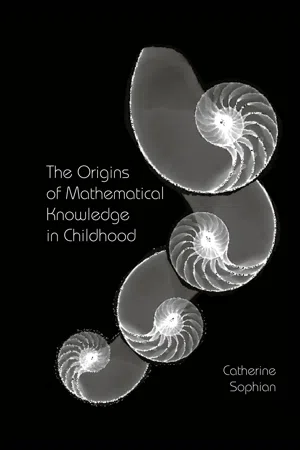Mathematics
Fractions
Fractions represent a part of a whole and are written as a ratio of two numbers, with the top number (numerator) representing the part and the bottom number (denominator) representing the whole. They are used to express quantities that are not whole numbers, and can be added, subtracted, multiplied, and divided to perform mathematical operations involving parts of a whole.
Written by Perlego with AI-assistance
Related key terms
1 of 5
11 Key excerpts on "Fractions"
- eBook - ePub
Teaching Fractions and Ratios for Understanding
Essential Content Knowledge and Instructional Strategies for Teachers
- Susan J. Lamon(Author)
- 2020(Publication Date)
- Routledge(Publisher)
Although elementary textbooks have traditionally addressed decimals and percentages as separate (and later) topics in the math curriculum, decimals and percentages are really just special kinds of Fractions with their own notation. There are several good reasons for arguing that right from the start of fraction instruction, children should be encouraged to express themselves in any or all of these forms. Children see decimals and percentages more in everyday life than they see Fractions. As we know, learning in contexts is a complex and lengthy process, so “saving” children from decimals and percentages until much later is a poor excuse that only cuts short their experiences. Most compelling is the fact that research has shown that by third grade, some children have already developed preferences for expressing quantities as decimals or percentages. (In this book you will see some of their work.)What Are Fractions?
Today, the word “fraction” is used in two different ways. First, it is a numeral. Second, in a more abstract sense, it is a number.First, Fractions are bipartite symbols, a certain form for writing numbers:. This sense of the word fraction refers to a form for writing numbers, a notational system, a symbol, a numeral, two integers written with a bar between them.a bSecond, Fractions are non-negative rational numbers. Traditionally, because students begin to study Fractions long before they are introduced to the integers, a and b are restricted to the set of whole numbers. This is only a subset of the rational numbers.The top number of a fraction is called the numerator and the bottom number is called the denominator. The order of the numbers is important. Thus, Fractions are ordered pairs of numbers, sois not the same as the fraction3 4. Zero may appear in the numerator, but not in the denominator.4 3All of these are Fractions in the sense that they are written in the form:a b,− 34π 2,4 2,,− 12.214.41 21 4However, they are not all Fractions in the second sense of the word. Therefore, I will say fraction form when I mean the notation, and fraction when I mean non-negative rational numbers.Rational Numbers
Although many people mistakenly use the terms Fractions and rational numbers - eBook - PDF
Mathematics for Elementary Teachers
A Contemporary Approach
- Gary L. Musser, Blake E. Peterson, William F. Burger(Authors)
- 2013(Publication Date)
- Wiley(Publisher)
NCTM Standard All students should develop understanding of Fractions as parts of unit wholes, as a part of a collection, as locations on number lines, and as divisions of whole numbers. Reflection from Research Students need to develop not only a conceptual understanding of Fractions, but also an under- standing of the proper notation of Fractions (Brizuela, 2006). Fractions A fraction is a number that can be represented by an ordered pair of whole num- bers a b (or a b / ), where b ≠ 0. In set notation, the set of Fractions is F a b a b b = ≠ ⎧ ⎨ ⎩ ⎫ ⎬ ⎭ | . and are whole numbers, 0 D E F I N I T I O N 6 . 1 On a piece of paper explain, using pictures, why 3 4 -and 6 8 are equivalent. Compare and contrast your explanation with that of your peers. Fractions can also be represented on a number line. The fraction 1 b is located on a number line by defining the interval from 0 to 1 as the whole and partitioning it into b equal parts. Each part is of length 1 b and the number 1 b is located at the right endpoint of the part with its left endpoint at 0 as shown in Figure 6.4. Figure 6.4 Common Core – Grade 3 Understand a fraction 1/b as the quantity formed by 1 part when a whole is partitioned into b equal parts; understand a fraction a/b as the quantity formed by a parts of size 1/b. Section 6.1 The Set of Fractions 211 The fraction a b is located on the number line by starting at 0 and marking off a copies of the length determined by the fraction 1 b end to end as shown in Figure 6.5. The right endpoint of the ath copy is the location of the fraction a b . 0 1 Figure 6.5 Before proceeding with the computational aspects of Fractions as numbers, it is instructive to comment further on the complexity of this topic—namely, viewing Fractions as numerals and as numbers. Recall that the whole number three was the attribute common to all sets that match the set { , , } a b c . - eBook - PDF
- Robert Reys, Mary Lindquist, Diana V. Lambdin, Nancy L. Smith(Authors)
- 2014(Publication Date)
- Wiley(Publisher)
Although there are other types of Fractions such as compound Fractions and decimal Fractions, in this chapter we use fraction to mean a common fraction. 1. Both Fractions and whole numbers represent a given amount. A fraction is represented with two whole numbers (numerator and denominator). All whole numbers are Fractions (think of how you can write 2 in fraction form), but not all Fractions are whole numbers. 2. A whole number has one meaning (how many), but a fraction has many meanings. We will examine this statement more fully in the section on meanings of Fractions. 3. There is only one symbol for each whole number amount, but there are many different symbols that express the same fractional amount. For example, the symbol, 2, indicates two of something but 3 5 , 6 10 , and 18 30 each expresses the same fractional amount. 4. Between any two whole numbers, there are a finite number of other whole numbers (or none). For example, between 3 and 7 are three whole numbers 4, 5, and 6. Between 5 and 6 there are no whole numbers. Between any two Fractions, there is always another fraction. For example, between 3 8 and 5 8 there is 4 8 , but 7 16 , 8 16 , and 9 16 are also between 3 8 and 5 8 . And between any two of these, there are more Fractions— an infinite number. 5. There are problems that can be solved with frac- tions but cannot be solved with whole numbers. BACKGROUND KNOWLEDGE The whole 3 5 244 Chapter 12 • Fractions any of these attributes; we have chosen to introduce the models with the part–whole meaning. Other attributes, such as capacity, volume, and time, can also model both meaning of Fractions. These models are used not only to develop the meanings of Fractions but also to find equivalent Fractions, to order frac- tions, and to solve problems involving operating with Fractions. Often students do not realize that these models can be helpful in solving problems (Wearne & Kouba, 2000). - Robert Brechner, Geroge Bergeman(Authors)
- 2019(Publication Date)
- Cengage Learning EMEA(Publisher)
Fractions A mathematical way of expressing a part of a whole thing. For example, 1 4 is a fraction expressing one part out of a total of four parts. 2-1 numerator The number on top of the division line of a fraction. It repre-sents the dividend in the division. In the fraction 1 4 , 1 is the numerator. denominator The number on the bottom of the division line of a fraction. It represents the divisor in the division. In the fraction 1 4 , 4 is the denominator. division line The horizontal or slanted line separating the numera-tor from the denominator. The symbol representing “divided by” in a fraction. In the fraction 1 4 , the line between the 1 and the 4 is the division line. SECTION I 2 8 8 5 8 3 8 Fractions such as 3 8 and 5 8 , in which the numerator is smaller than the denominator, rep-resent less than a whole unit and are known as common or proper Fractions . Some examples of proper Fractions are 3 16 three-sixteenths 1 4 one-fourth 9 32 nine-thirty-seconds When a fraction’s denominator is equal to or less than the numerator, it represents one whole unit or more and is known as an improper fraction . Some examples of improper Fractions are 9 9 nine-ninths 15 11 fifteen-elevenths 19 7 nineteen-sevenths common or proper frac-tions Fractions in which the numer-ator is less than the denominator. Represent less than a whole unit. The fraction 1 4 is a common or proper fraction. improper fraction A fraction in which the denominator is equal to or less than the numerator. Represents one whole unit or more. The fraction 4 1 is an improper fraction. Copyright 2020 Cengage Learning. All Rights Reserved. May not be copied, scanned, or duplicated, in whole or in part. Due to electronic rights, some third party content may be suppressed from the eBook and/or eChapter(s). Editorial review has deemed that any suppressed content does not materially affect the overall learning experience.- eBook - ePub
- Marcus Witt, Marcus Witt, Author(Authors)
- 2014(Publication Date)
- Learning Matters(Publisher)
The understanding of one interpretation does not necessarily lead to that of another (Brousseau et al., 2004; Charalambous and Pitta-Pantazi, 2007). Therefore to have a complete understanding of Fractions requires an understanding of the different representations and how they interrelate (Kieren, 1976).Figure 6.2 The iTalk2Learn Interpretations and Representations Matrix (Hansen et al, 2014)Teaching Fractions
This section provides support for putting the theoretical subject knowledge discussed earlier into practice. There are some terms that will be used throughout, and so they are defined here for you.Curriculum Link
Did you know that the Primary National Curriculum mentions ‘fraction’ 116 times? It is a significant number given that ‘whole number’ appears only 25 times. The document outlines clear progression in the objectives from Year 1 to Year 6, but it is essential that you read the non-statutory notes and guidance alongside the statutory requirements because these give pedagogical advice including thinking about connections and contexts.A unit fraction is the basic unit of any fraction. The numerator is always 1, for example ½, 1/6, 1/10 and 1/36.A proper fraction is any fraction where the numerator is smaller than the denominator, for example 3/5, ⅞, 2/10 and 13/25.An improper fraction is a fraction where the numerator is larger than the denominator, for example 5/2, 8/4. 12/9 and 30/6.A mixed number is written as a whole number and a fraction, for example and .Writing Fractions
Fractions are a number in their own right, and are represented by a symbol . Because children have a stronger understanding of whole numbers than Fractions, they will see the parts in the symbol as two whole numbers and are unlikely to see the relationship between the numbers and the role each part has in defining the fraction. This is why a careful definition of numerator and denominator is important. So a child may say two out of three or two threes for 2/3. This emphasises the respective absolute magnitudes of the numerator and denominator rather than the relationship between them. It also does not generalise well to improper Fractions: 4/3 as ‘four out of three’ is not helpful (Clark and Roche, 2009). Therefore it is important to support children to begin to see the fraction symbol as one made up of a numerator and a denominator (not simply two whole numbers) by using the terms numerator and denominator to reinforce their special role in the fraction symbol. - eBook - PDF
- Charles P. McKeague(Author)
- 2011(Publication Date)
- XYZ Textbooks(Publisher)
DEFINITION The Meaning and Properties of Fractions 144 Chapter 2 Fractions 1: Multiplication and Division EXAMPLE 1 Name the numerator and denominator for each fraction. a. } 3 4 } b. } 5 a } c. } 7 1 } SOLUTION In each case we divide the numerator by the denominator: a. The terms of the fraction } 3 4 } are 3 and 4. The 3 is called the numerator, and the 4 is called the denominator. b. The numerator of the fraction } 5 a } is a. The denominator is 5. Both a and 5 are called terms. c. The number 7 may also be put in fraction form, because it can be written as 7 _ 1 . In this case, 7 is the numerator and 1 is the denominator. CLARIFICATION 1: The Fractions } 3 4 }, } 1 8 }, and } 1 9 0 } are all proper Fractions, because in each case the numerator is less than the denominator. CLARIFICATION 2: The numbers } 9 5 }, } 1 1 0 0 }, and 6 are all improper Fractions, be- cause in each case the numerator is greater than or equal to the denominator. (Remember that 6 can be written as } 6 1 }, in which case 6 is the numerator and 1 is the denominator.) Fractions on the Number Line We can give meaning to the fraction } 2 3 } by using a number line. If we take that part of the number line from 0 to 1 and divide it into three equal parts, we say that we have divided it into thirds (see Figure 2). Each of the three segments is } 1 3 } (one third) of the whole segment from 0 to 1. DEFINITION For the fraction } b a }, a and b are called the terms of the fraction. More specifically, a is called the numerator, and b is called the denominator. DEFINITION Video Examples Section 2.1 DEFINITION A proper fraction is a fraction in which the numerator is less than the denominator. If the numerator is greater than or equal to the denominator, the fraction is called an improper fraction. DEFINITION Note There are many ways to give meaning to Fractions like } 2 3 } other than by using the num- ber line. One popular way is to think of cutting a pie into three equal pieces, as shown below. - eBook - PDF
Making Sense of Number
Improving Personal Numeracy
- Annette Hilton, Geoff Hilton(Authors)
- 2021(Publication Date)
- Cambridge University Press(Publisher)
Thinking fractionally can be harder to visualise than whole-number thinking so it might be handy to grab some simple hands-on materials like buttons or counters to help work your way through certain scenarios or learning activities. Fractional thinking can involve common Fractions, decimals or percentages. As mentioned already, many people report difficulties with fractional thinking, and some identify it as the core reason for their lack of mathematical confidence. In this chapter some of the commonly identified difficulties are discussed, which we hope will allow you to relate to your personal experiences. Fractional thinking can doubtless become complicated, but in our day-to-day lives most of the numeracy situations involving Fractions can be met with an understanding of a few basic fraction concepts. In school we probably encountered rather complex fractional algorithms, which are important for deep understanding of Fractions but not so necessary for personal functional competence. To ground the chapter in personal number sense, images and scenarios from everyday situations will provide opportunities to illustrate and apply the fractional concepts. This chapter is focused on three types of Fractions. The three main ways to think fractionally is with common Fractions (e.g. 3 4 ), decimal Fractions (e.g. 0.75) and percentages (e.g. 75%). We will start with common Fractions. COMMON Fractions The definition of a fraction that most people are aware of is that it is a ‘part of a whole’. This is a reasonable working definition, so we will keep working with it. This section deals with common Fractions (called ‘vulgar Fractions’ Common Fractions are numbers that are expressed using two whole numbers in the form a b , as shown in Figure 7.1. For example: 1 2 , 3 4 , 11 20 , 12 7 110 Making Sense of Number in the past). A fascinating experience we have with many students is that they are able to identify the parts of a common fraction, but don’t know what the words mean. - eBook - PDF
- Michael A. Calter, Paul A. Calter, Paul Wraight, Sarah White(Authors)
- 2016(Publication Date)
- Wiley(Publisher)
9–1 Simplification of Fractions Parts of a Fraction A fraction has a numerator, a denominator, and a fraction line. fraction line a b numerator denominator Quotient A fraction is a way of indicating a quotient of two quantities. The fraction a/b can be read “a divided by b.” The two ways of writing a fraction, a b and a/b, are equally valid. Ratio We also speak of the quotient of two numbers or quantities as the ratio of those quantities. Thus the ratio of x to y is x y . 9 ◆◆◆ OBJECTIVES ◆◆◆◆◆◆◆◆◆◆◆◆◆◆◆◆◆◆◆◆◆◆◆◆◆◆◆◆◆◆◆◆◆◆◆◆◆◆◆◆◆◆◆◆◆◆◆◆◆◆◆◆◆◆◆◆◆◆◆ When you have completed this chapter, you should be able to: • Simplify fractional expressions. • Multiply and divide fractional expressions. • Add and subtract fractional expressions. • Simplify complex fractional expressions. • Solve fractional equations. • Solve word problems using fractional equations. • Manipulate and work with literal equations and formulas. You already know about Fractions with numbers. In algebra, however, the numbers are replaced with letters, coefficients, and even entire expressions. Many equations and formulas in science and technology are in the form of a fraction. Since the rules of working with the numerators and denominators of Fractions must be applied to entire algebraic expressions, we’ll need to make much use of the factoring techniques of Chapter 8 in order to simplify them. As we work with formulas that include Fractions, we must be careful: it’s very easy to make mistakes when we cross multiply. Remember that any- thing you do must be done to each term on both sides of the equation. Also, don’t be intimidated by complex Fractions where a numerator or denominator might contain a fraction; use your skills and take it one step at a time. Not all of this material is new to us. Some was covered in Chapter 2, and we solved simple fractional equations in Chapter 3. Fractions and Fractional Equations - Mark Zegarelli(Author)
- 2022(Publication Date)
- For Dummies(Publisher)
CHAPTER 10 Understanding Fractions 179 The result is that each fraction now has a new number written underneath it. The larger num- ber is below the larger fraction. You can use cross-multiplication to rewrite a pair of Fractions as two new Fractions with a com- mon denominator: 1. Cross-multiply the two Fractions to find the numerators of the new Fractions. 2. Multiply the denominators of the two Fractions to find the new denominators. When two Fractions have the same denominator, the one with the greater numerator is the greater fraction. Q. Which fraction is greater: 5 8 or 6 11 ? A. 5 8 . Cross-multiply the two Fractions: Because 55 is greater than 48, 5 8 is greater than 6 11 . Q. Which of these three Fractions is the least: 3 4 , 7 10 , or 8 11 ? A. 7 10 . Cross-multiply the first two Fractions: Because 28 is less than 30, 7 10 is less than 3 4 , so you can rule out 3 4 . Now compare 7 10 and 8 11 similarly: Because 77 is less than 80, 7 10 is less than 8 11 . Therefore, 7 10 is the least of the three Fractions. 19 Which is the greater fraction: 1 5 or 2 9 ? 20 Find the lesser fraction: 3 7 or 5 12 . 21 Among these three Fractions, which is greatest: 1 10 , 2 21 , or 3 29 ? 22 Figure out which of the following Fractions is the least: 1 3 , 2 7 , 4 13 , or 8 25 . 180 UNIT 4 Fractions Working with Ratios and Proportions A ratio is a mathematical comparison of two numbers, based on division. For example, suppose you bring 3 shirts and 5 ties with you on a business trip. Here are a few ways to express the ratio of shirts to ties: 3:5 3 to 5 3 5 A good way to work with a ratio is to turn it into a fraction. Be sure to keep the order the same: The first number goes on top of the fraction, and the second number goes on the bottom. You can use a ratio to solve problems by setting up a proportion equation — that is, an equation involving two ratios.- Catherine Sophian(Author)
- 2017(Publication Date)
- Routledge(Publisher)
Although the results that have been reported to date are very positive, a caveat is that both programs have been evaluated only in terms of immediate student achievement. We do not know how well students retain what they have learned or how effectively they progress to more advanced topics. Furthermore, the assessment instruments inevitably reflect the researchers’ own judgments about what is important and may not adequately assess aspects of fraction knowledge that are important from other perspectives. In particular, neither assessment provided information specifically on children’s understanding of Fractions as involving the construction of new units of measurement. Of course, it might be argued that that is not important so long as the students can apply Fractions appropriately to physical quantities, understand the magnitude relations between them, and operate effectively with them. Ultimately, this issue can only be resolved in the context of a longer term vision of what we want students to learn, not only about Fractions but about mathematics as a whole.MATHEMATICAL DEVELOPMENT THROUGH THE ELEMENTARY YEARS
Fractions are the culmination of the “mathematics of numbers”—the knowledge that children have been developing since they began to count about the use of numbers to represent relationships among quantities. An influential thesis has been that Fractions are difficult to learn because they must be superimposed on the basically incompatible way that children think about whole numbers, a way of thinking that is grounded in the counting procedure with its implications that each number has a successor and that these successive numbers map in a one-to-one fashion into the elements of a set (R. Gelman, 1991). A difficulty with this thesis, however, is that it suggests that the difficulties students experience are intrinsic to the nature of Fractions, and thus that understanding Fractions is likely to be a challenge for students no matter how they are taught. That implication is inconsistent with the successes of new approaches to fraction instruction such as those of Moss and Case (1999) and of the RNP (Cramer & Post, 1995; Cramer et al., 2002). Although it is almost certainly true that fraction learning is more dependent on explicit instruction than learning to count is, it is now clear that the judicious use of concrete representations to help students understand Fractions as representations of magnitude can markedly facilitate the fraction-learning process. The shared emphasis on understanding fraction magnitudes in the instructional methods developed by the RNP and by Moss and Case (1999) strongly supports the view that Fractions, like whole-number concepts, build critically on understanding the principles of representing magnitudes numerically.- Joan Cohen Jones(Author)
- 2011(Publication Date)
- Wiley(Publisher)
The numerator is the counting number. The denominator tells what is being counted (fourths, fifths, sixths, etc.). Fraction Comparison and Equivalence LEARNING OBJECTIVES 1. Compare and contrast several methods for comparing and ordering Fractions. 2. Describe the meaning of equivalent Fractions. B oth the Common Core State Standards (NGA Center/CCSSO, 2010) and Curriculum Focal Points (NCTM, 2006, p. 15) recommend that in grade 3, children “solve problems that involve comparing and ordering Fractions by using models, benchmark Fractions, or common numerators or denominators. They understand and use models, including the number line, to identify equivalent Fractions.” In grade 4, they develop “techniques for generating equivalent Fractions and simplifying Fractions” (p. 16). Methods for Comparing and Ordering Fractions When learning about Fractions, the concept of the whole is very important. Children should understand that, when comparing and ordering Fractions, they are always 3. Identify strategies for finding equivalent Fractions. equivalent Fractions Fractions that represent the same quantity with different numbers. 1. When teaching children to find equal shares, why is it easiest to begin with activities that share by multiples of 2? 2. How can the process of iteration prepare children to learn the meanings of improper Fractions and mixed numbers? 3. What difficulties might children have with Fractions if they learn to use expressions such as “5 out of 6”? numerator This part of the fraction counts how many equal shares you have. denominator This part of the fraction tells the number of equal parts the whole has been parti- tioned into. working with the same-size whole. Misunderstanding of this concept can lead to errors. Virtual Classroom Observation Click on Student Companion Site. Then click on: • Foundations of Effective Mathematics Teaching • B.
Index pages curate the most relevant extracts from our library of academic textbooks. They’ve been created using an in-house natural language model (NLM), each adding context and meaning to key research topics.
